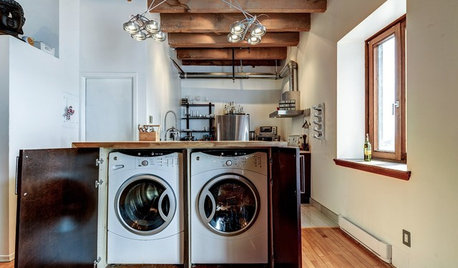Dryer Vent Collecting Water
j2bohan
11 years ago
Related Stories

REMODELING GUIDESContractor Tips: Advice for Laundry Room Design
Thinking ahead when installing or moving a washer and dryer can prevent frustration and damage down the road
Full Story
GREEN BUILDINGWater Sense for Big Savings
Keep dollars in your pocket and preserve a precious resource with these easy DIY strategies
Full Story
GREEN DECORATINGEasy Green: Big and Small Ways to Be More Water-Wise at Home
These 20 tips can help us all make the best use of a precious resource. How do you save water in summer?
Full Story
LIFEThe Top 5 Ways to Save Water at Home
Get on the fast track to preserving a valuable resource and saving money too with these smart, effective strategies
Full Story
DISASTER PREP & RECOVERYRemodeling After Water Damage: Tips From a Homeowner Who Did It
Learn the crucial steps and coping mechanisms that can help when flooding strikes your home
Full Story
ARCHITECTUREWant to Live by the Water? What You Need to Know
Waterside homes can have amazing charm, but you'll have to weather design restrictions, codes and surveys
Full Story
SHOP HOUZZShop Houzz: Large Kitchen Appliance Sale
Save up to 25% on modern ovens, ranges, cooktops, hoods, vents and more
Full Story0

LAUNDRY ROOMSA Kitchen Laundry Cabinet Full of Surprises
A little DIY spirit allowed this homeowner to add a washer, dryer, kitchen countertop and dining table all in one
Full Story
KITCHEN DESIGNA Cook’s 6 Tips for Buying Kitchen Appliances
An avid home chef answers tricky questions about choosing the right oven, stovetop, vent hood and more
Full Story
SMALL KITCHENS10 Things You Didn't Think Would Fit in a Small Kitchen
Don't assume you have to do without those windows, that island, a home office space, your prized collections or an eat-in nook
Full StoryMore Discussions









fahrenheit_451
dadoes
Related Professionals
Commerce City Kitchen & Bathroom Designers · Rancho Mirage Kitchen & Bathroom Designers · South Farmingdale Kitchen & Bathroom Designers · Channahon Kitchen & Bathroom Remodelers · North Plainfield Cabinets & Cabinetry · Oshkosh Custom Closet Designers · Apple Valley Flooring Contractors · Chalmette Flooring Contractors · Cutlerville Flooring Contractors · Lodi Flooring Contractors · Miami Flooring Contractors · Moorhead Flooring Contractors · Newburgh Flooring Contractors · Norwood Flooring Contractors · Westerville Flooring Contractorsj2bohanOriginal Author
dadoes
j2bohanOriginal Author
mike_kaiser_gw
fahrenheit_451